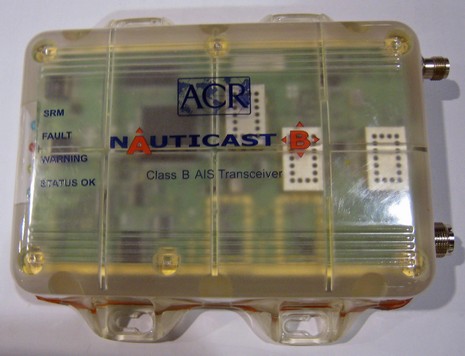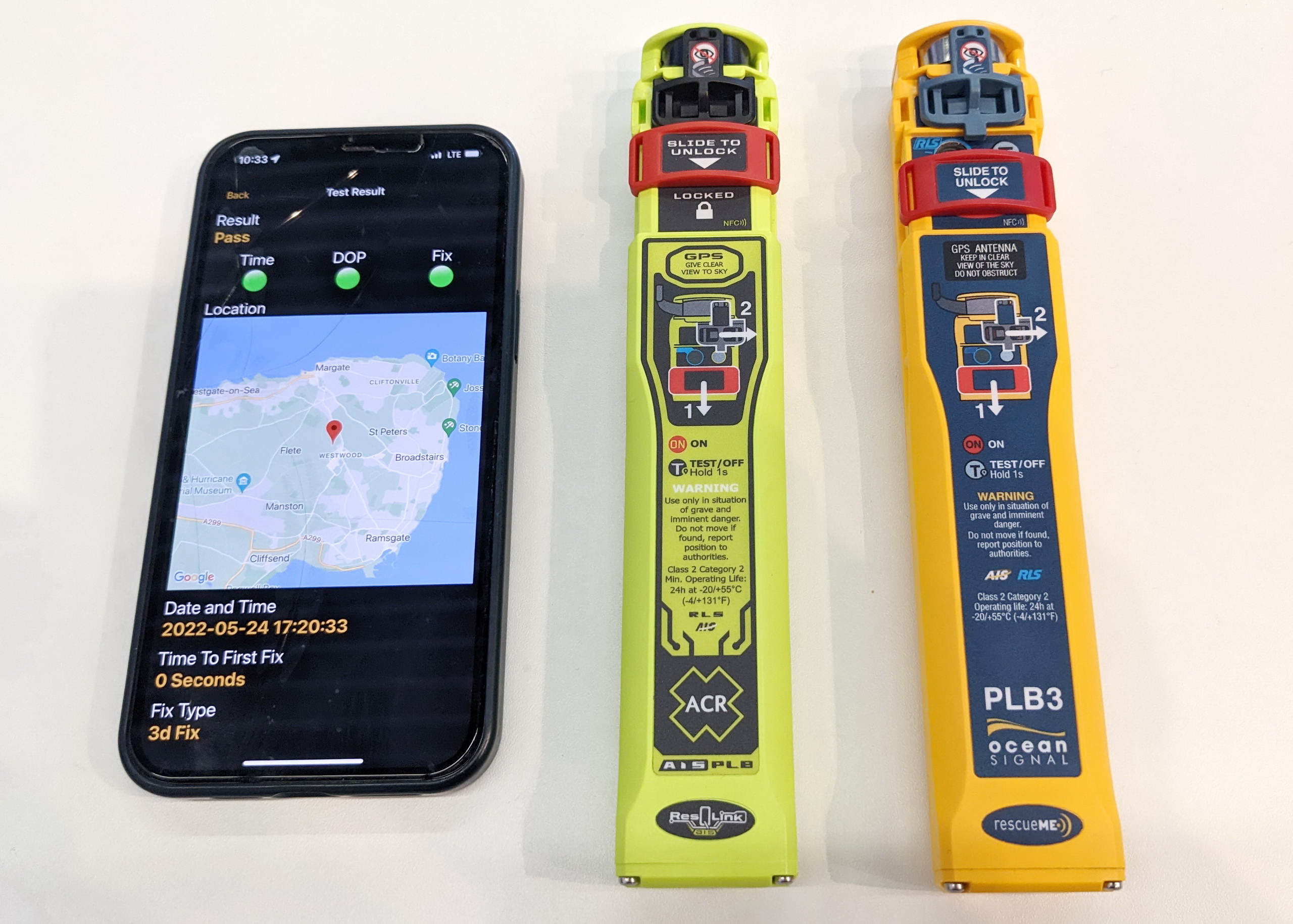ACR Nauticast B, a new Class B playa

Over the years, I’ve gotten the impression that the FCC can be a capricious, even frightening, regulatory agency. For instance this is the only prototype Class B AIS that was actually shown to the public in Miami (I think), and ACR asked that I include the disclaimer below in this entry. At any rate, the Nauticast B looks pretty attractive (bigger image here). It’s quite compact at less than 8 x 6.5 x 2 inches—the translucent case apparently helping with its “water resistance” while letting the four LED status lights shine through—and it will retail for $1,000 (once it’s approved). It comes with a remote SRM (safety related message) send button which, like the SevenStar, can be reprogrammed by the user to instead turn quiet mode (receive but don’t transmit) on and off. But probably the most important thing about this box is the name on it. ACR’s reputation for quality, reliability, and support will be a real boon to AIS Class B adoption (as the new receivers from Furuno and Raymarine will be for AIS awareness overall). So, please, FCC, let’s get on with it!
This device has not been authorized as required by the rules of the Federal Communications Commission. This device is not, and may not be, offered for sale or lease, or sold or leased, until authorization is obtained.













Ben, can you tell us ?
– While not transmitting, does it have a real dual channel receiver ?
– NMEA 0183 or 2000 interface ?
– If NMEA 0183, does it have a built in multiplexing?
– Power consumption ?
– Compatibility with Chartplotters from whom?
– Presumably needs a dedicated VHF antenna ?
Cheaper than Raymarine AIS-250? So, for us Raymarine users, we have a choice between $1,200 AIS-250, and a $1,000 full blown ACR transiever (plus costs of an added antenna, 0183 interface, etc.).
Only one SRM? 14 characters right? Would rather have many programmable messages to choose from, like “Racing StayClr”, “Committee Boat”, “Beware Dog”, “Sails Up/Down”, “Student Driver”, “USCG is #1”, “Panbo Fan Aboard”
Also, transmit off as seperate switch that can be remote installed at helm, so you can disable as you go thru no wake zones a tad fast, without broadcasting your boat speed.
Although some clever NMEA interfacing can be used to disable sending boat speed, … an additional option to show an SMR with my sail# during a race (to the committe boat), without transmitting my boat speed to my competition would make things simpler.
Ignore some of my previous messages, I still subscribe to the idea that class B transievers in the hands of the average boater is going to give a false sense of security, having a selection of SMR’s available to these people is just going to reinforce that. I can imagine boaters setting up clever SMR’s thinking that they have given fair warning of their intentions, when in fact few people will establish a situational awarness inclusive of such information. I live with just one SMR = “USA #1”
Howevere … a remote on/off switch for transmit vs receive only, would still make sense to provide positive feedback that transmit is on/off at a nav or helm station. Presumably in the “off” position, you can save some power and/or not call attention to your boat speed in some situations (e.g. racing), and the “on” position might make sense … I don’t know, maybe never.
My overriding concern about Class B AIS is that ships will have a filter to remove them from their display. It seems like without a filter, a pilot bringing a ship into a major port would have a display cluttered with tens if not hundreds of class B targets that would defeat the whole purpose of AIS. The pilots aren’t going to tolerate being distracted by a collision warning alarm going off every time some 50′ recreational boater is on a collision course with his 900′ container ship.
Ships only care about class A targets, and not even all of those (e.g., ferries steer clear of container ships). Once given the ability to filter out the class B targets, I doubt too many ships will ever see a class B target.
I’m pretty sure that all Class B transponders transmit and receive on both AIS frequencies, and that they include an integral GPS that you can not muck with. (It’s less clear to me if the GPS data always outputs along with the AIS targets). The Nauticast B has “RS232 and RS422 NMEA electrical interfaces”, both 38.4k and bidirectional, which is pretty standard, I think, and average power use is listed as 4 watts.
I don’t know much about SMR messages, but think you use your Class B interface to choose from a preformatted list. I suspect the ACR comes with its own software for this sort of configuration, but any ECS or Plotter that can plot AIS can use this as a receiver, and some will quickly be able to handle the few commands that you can give the transponder. I don’t know if SRM’s are limited to 14 characters, or even who exactly receives them, but “Panbo Fan Aboard”, wonderful as it is, doesn’t sound safety related. How about “Fussy Panbot Flaming”?
I am a huge fan of AIS and what it does for me safety wise. However, $1,000 is a little steep for me to broadcast my position, which will be ignored by most commercial vessels anyway.
I am not sure what the price point is for recreational vessels. The components, a GPS can be had for $100, a VHF radio for $150, and an AIS receiver for $250. I expect the clas B transponder will come down significantly in price.
Pat Harman
From Holger at Yacht-AIS:
“Regarding SRM (Safety Related Messages), these can be generally received by every AIS receiver or transponder or coastal base station (except the NASA engine). The content is limited to safety of shipping related matters, while a free text message is also available, but not allowed for Class B units to broadcast (receive-only for Class B). Generally, a SRM can be 168 characters long, but to prevent channel overloading, Class B units have been limited to 14 characters . The content is not free text, but has to be predefined by hardware or software manufacturers. Therefor, our Yacht-AIS Transponder software is capable of transmitting these messages.”
Russ:
I have heard the comment that the Class B’s are going to clutter up the big ships displays, but I’m confused here – how is this different to the radar display, which (I would hope) would pick up every target in any case….. ‘cos everyone DOES use a decent radar reflector, right?
I completely agree with the comments of the “false snese of security” that some people may get with a transponder on board (this is true of both Class A and B) – just becuase you are transmitting doesn’t mean to say that anyone is actually listening (or indeed, capable of doing anything about it, in any case!). It scares me to see that in many commercial vessels, the AIS display is just a 4-line LCD dot matrix listing the four closest contacts….. ironic that in many cases, it looks like lesuire boaters are likely to have better ECDIS than some commercial craft….
Ocean Equipment introduced Comar AIS at Miami as well and the Comar CSB200 Cls B Transponder was on display along with the SLR200 (Cls A) and SLR200G. The Comar CSB200 will be available as soon as Class B is authorized.
Thanks! Is that http://www.oceanequipment.com?
Del: I’ve never see how radar is operated on a commercial ship, but on my radar the size of the target is pretty obvious. It’s easy to distinguish a 900′ container ship from a 44′ sailboat, even a 44′ sailboat with a radar reflector. I’m sure that we do clutter up the radar, but we’re also safely ignored.
With AIS, we all show up the same, you have to read the meta-data to find out whether the target is an aircraft carrier or a SeaRay.
Are there any merchant marine officers out there that would share their perspective in Class B?
I believe that one of the concerns mentioned here and elsewhere about there going to be hundreds if not thousands of Class B “bees” cluttering-up the screens is not going to come true any time soon. Face it, these units will cost an average of $1000 being a lot of money for the average boater. Most boaters I know, are not even willing or interested to spend $250 on an AIS receiver. On the other hand, being an electronics junkie, am going to buy a B class unit very soon.
Russ:
“With AIS, we all show up the same, you have to read the meta-data to find out whether the target is an aircraft carrier or a SeaRay.”
Not necessarily true – the ECDIS wil usually show the AIS target with its dimensions graphically (at least Shipploter and SeaClear do) so it is immediately obvious what size the AIS target is.
At the end of the day, all things considered, I still fervently believe that life on the seas with a Class B on board SHOULD be a lot safer than without it.